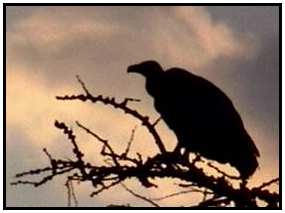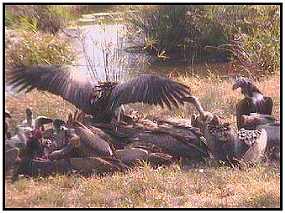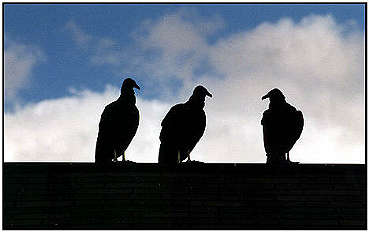How Birds Are NamedClassification of any species involves the sorting of them into increasingly smaller categories. Most people find this extremely confusing, but when taken step-by-step it is quite clear and prevents bird species getting confused, a problem which often occurs when common names are utilised. The classification process is applied to every living thing and is as follows: Kingdom: In the case of birds this is Animal (as against plant).
African White-Backed Vulture (Photograph Courtesy of Africam (Copyright ©2000)Phylum: is Chordata. This refers to animals with a dorsal supporting rod, or notochord. With most adult chordates, it is replaced by a backbone (the vertebrates). Class: Aves. This is simply the Latin for 'birds' and so excludes mammals and fishes. From here on in we will trace the vultures, specifically, Gypaetus barbatus, common name, the Bearded Vulture. Order: The Bearded Vulture belongs to the order Falconiformes which encompasses over 270 species. This includes vultures, hawks, falcons and eagles (owls are not included in this order). All have hooked beaks for tearing flesh and most have talons, with the vultures having weaker feet as they feed on carrion and need not hold their prey to prevent it escaping. There are around 8,600 living species of birds and ornithologists assign each one to twenty-seven major groups or 'orders', though agreement on where a bird should be is not always universal and new discoveries about a particular bird can see them change.
A Mix of Vultures feeds on a CarcassFamily: Orders are further broken down into families; for our focus bird this is Accipitridae. These birds of prey are characterised by short rounded wings and a long tail. Among the family members are some vultures, eagles, hawks and kites. Genus: Gypaetus. Gys is Greek for vulture and refers to the fact that vultures are always hungry. The aetus portion refers to eagles. Species: Barbatus. Latin for bearded. In short, 'Gypaetus barbatus', literal translation: 'vulture eagle with a beard'. Known more commonly as the Bearded Vulture, (note that only the generic and specific names are used for its designation).
Turkey Vulture (Photograph Courtesy of Lisa Purcell ©2000)
|



